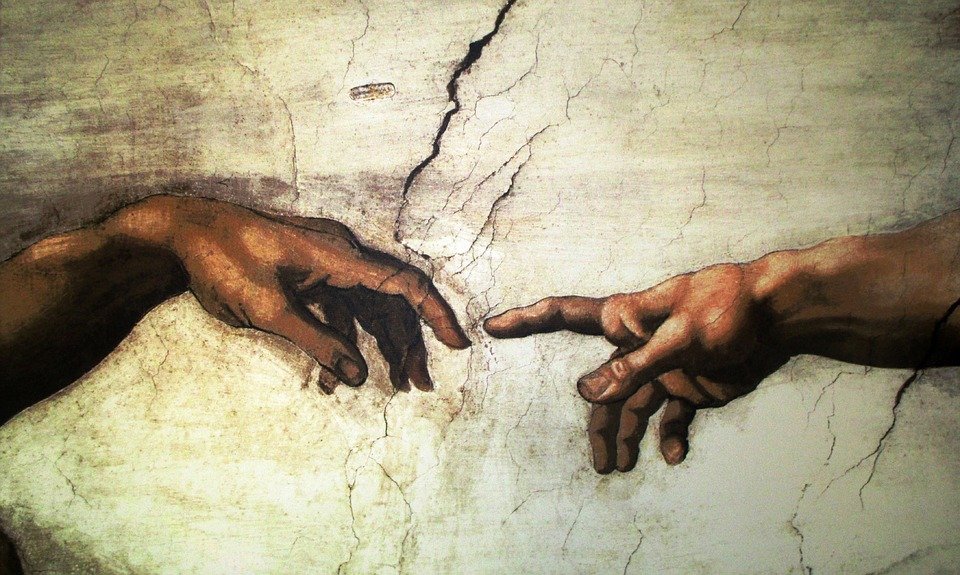Love Brings Us to Life
Evangelicals are fond of saying “The church is an organism, not an organization.” I draw their attention to the high degree of organization found in every living organism. I sympathize, though, with their wariness of a man-made organization (the Catholic Church) claiming a higher value than their experience of lived relationship with Christ. I hope we can learn from them about opening our structures – personal and institutional – to the living presence of Our Lord. I hope they can learn from us about the fact that God chose to place himself into the keeping of a collaboration of persons, and mediates himself to the world through men and the structures they create. These might be social structures like families and organizations, or verbal, like books and works of art.
The truth is that the Church is a man-and-God-made organization with the interior quality of life made possible by the love flowing from the communion of the Trinity into the communion of persons. The verbal structures we Christians create are to be works of truth filled with love, or of love, filled with truth. The institutions we Christians create are to be works of our making filled with the Presence of Christ, or of God’s making and filled with our real presences. The two ways of looking at the interaction of truth-with-love, of God-with-man, or of organization-with-organic-life reflect the paradox at the root of what God has accomplished in the New Things made possible by the Crucifixion and Resurrection.
Where there was no way, Christ made a way. Where there was a dead man who could not act in unity with God, there is a new man who can. Where there were institutions made empty by the flatness of man – relationships made transactional, gift shrunken to exchange, possibility narrowed to necessity – there are now institutions which, through His people, God turns into vessels of our mutual presence, and Christ’s. The organizations we now create may develop the qualities of living organisms to the extent we open them to the light and love of the living God.
How does a ‘mere organization’ differ from a ‘God-bearing organism’? Both have structure, but the diagram of the first can be expressed as a top-down arrangement of little job-boxes that represent people who are functionaries accomplishing the goals of the larger box, The Institution. The organism, while jobs and reporting relationships may form the ‘skeleton,’ are better represented by a messier diagram: one that takes into account the various networks formed within the institution by the living relationships, movements, communication patterns, interest intersections, and other constantly-developing aspects that emerge from interaction of the parties within and without. The organism, while harder to reduce to a two-dimensional diagram, is far superior to the mere organization in many respects.
It is bigger on the inside than the outside, because life bubbles up and pushes the boundaries of its self-definition, or external-facing identity. It is robust by virtue of the many overlapping channels of communication and connection, and so is more resilient to prosper in the face of challenges. It is more capable of interacting and integrating with the world around it due to the two-directional nature of communication, which provides (in addition to the top-down and task-oriented communications typical of ‘mere organizations’) constant feedback from its most-external, and its hierarchically-lowest members. Yes, these qualities make it a lot ‘messier’ to manage than the mere organization. And that’s the price you pay for the freedom of the people within.
Alastair MacIntyre lamented the ‘organization man,’ made small by being formed to fit ‘mere organizations,’ and factories. Others called him ‘mass man,’ and I have called him ‘flat man.’ C.S. Lewis called him a man without a chest. The God-and-man-made, messy organism that is our family, our institution, our Church, corresponds to an entirely different human person: the new man, the unique and unrepeatable mystery who is your neighbor, the three-dimensional man with an interior dimension that is enormous and eternal. This is the man made fit to exercise the glorious freedom of the children of God. The ‘mere organization’ cannot do justice to a human person because it cannot be filled with love. One ‘organism’ was created to be filled with love – the human being. When our organizations come to life and grow, they begin to resemble a human body in dimension and complexity. Our organizations are suited to human formation to the degree we, in communion, in unity, in freedom, welcome the Love who made us to fill them with His presence.
May God keep us from smaller, easier enterprises, and give us grace to do the work of learning to be free, to offer unity and love to one another, to collaborate, and to forgive.


